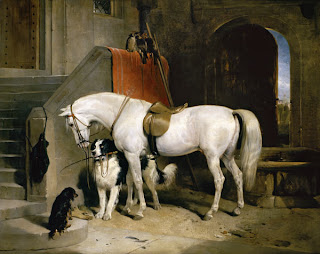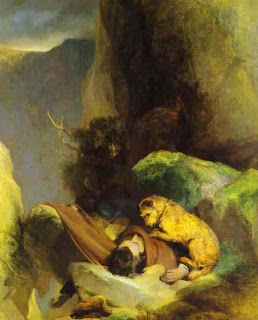Edwin Henry Landseer
(1802-1873)
Image courtesy of: http://www.npg.org.uk/
One of the most prominent (animal) artists of the nineteenth century, Edwin Henry Landseer - painter, etcher, sculptor and animalier known for his exceptional portrayals of stags, dogs and horses - was the youngest son in a family of seven children, born in March, 1802. His father, John Landseer, was an engraver who recognized the artistic leanings of his precocious son, whose first forays into the world of art were animal drawings, and fostered his innate talents. Edwin's early works were widely circulated in the form of engravings, often carried out by his brother, Thomas. From 1815, Edwin, along with two older brothers, studied under the tutelage of the historical painter, Benjamin Robert Haydon (1786-1846), who encouraged the young Edwin to study animals, including lessons in anatomy. (It is alleged that Edwin was given the carcass of a dead lion from a menagerie to dissect and which he thoroughly studied.) In 1816, Edwin enrolled in the Royal Academy of Arts (founded by George III in 1768), where he had already exhibited at the Academy's annual Summer Exhibition the previous year. In 1826, still in his early twenties, Landseer was elected Associate of the Royal Academy (ARA), becoming a full-fledged Royal Academician (RA) by 1831. (Sources: Morgan, H., victorianweb.org, 2010; artrenewal.org, undated; royalacademy.org.uk, 2010)
Lion: A Newfoundland Dog - 1824 Image courtesy of: http://www.vam.ac.uk/
Landseer traveled to Scotland for the first time in 1824 and fell in love with the Scottish Highlands which became a source of inspiration for many of his later works. While there, Landseer also paid a visit to Sir Walter Scott, who admired his paintings to the point of choosing Landseer as one of the illustrators to the Waverly editions of his novels. Landseer's paintings gained him an entry into exclusive social circles such as those of the Dukes of Atholl and Bedford and he moved easily within aristocratic society; indeed, in the 1830s, Landseer's works gained popular acclaim and were purchased by both the aristocracy as well as the newly-emerging middle-classes. (Source: Morgan, H., victorianweb.org, 2010)
Jocko and the Hedgehog - 1828
Image courtesy of: http://www.topofart.com/
In 1837, Landseer met the newly declared queen, Victoria, for the first time and for whom he made sketches of her favourite King Charles spaniel, "Dash." From then on, having secured royal patronage - especially in the 1840s when Victoria and Albert also discovered the rustic pleasures of the Scottish Highlands - he quickly became the favourite living artist of both the Queen and her Prince Consort for whom he painted many of the royal couple's favourite pets as well as personal portraits, paying his first visit to their new home in Scotland, Balmoral, in 1850, to paint a large group portrait of the Royal Family. (Although he never completed the painting, he was nonetheless knighted that same year.) Being a friend of Queen Victoria and with commissions pouring in from aristocratic patrons who embraced him socially, Landseer's position at court was secured. But in spite of his preeminent social connections and illustrious career among the nobility, within his personal life all was not as well as it appeared. (Sources: Morgan, H., victorianweb.org, 2010; artrenewal.org, undated)
Saved - 1856
The Arab Tent - 1866
Eros, A Favourite Greyhound of Prince Albert - 1841
Image courtesy of: http://www.topofart.com/
In the early part of 1840, Landseer's mother died, the loss of whom caused him to fall into a state of severe depression (which may also have been partly caused by the failure of the unfinished royal group portrait) and a mental breakdown ensued later in the year, from which he never entirely recovered. He was forced to rest. During his convalescence, Landseer decided to travel abroad into the Continent. On his tour, during which he was accompanied and looked after by his friend, the noted chemist and artist, Jacob Bell, Landseer made many drawings of local people and animals and his state of mental health made steady improvement. While he was incapacitated and unable to cope with the day-to-day tasks, Bell managed Landseer's business obligations and his aunt, Barabara Potts, along with his sister, Jessica, looked after Landseer's domestic affairs. During this unstable time of his life, Landseer became addicted to drugs, prescribed to assuage his mental distress while at the same time, he also became increasingly dependent on alcohol.
His psychological state and personal troubles notwithstanding, Landseer continued working, producing brilliant (yet often violent images of death and destruction) works of art till the end of his life. There existed a duality in Landseer's outlook on nature - both domesticated and wild: he was concurrently in awe of the natural places inhabited by the animals he loved to depict, while at the same time, he also revelled in representing the hunt and destruction of those very same animals. For most of his life, Landseer spent the autumn months in the Scottish Highlands, always a source of inspiration. (Sources: Morgan, H., victorianweb.org, 2010; artrenewal.org, undated)
Monarch of the Glen - ca. 1851
Image courtesy of: http://tsccwiki.wetpaint.com/
Scene in Braemar - Highland Deer
Burns' Twa Dogs - 1858
The above two images are courtesy of: http://pictopia.com/
In the 1860s, Landseer's mental state deteriorated further. On a number of occasions and due to his mental instability, he had to be confined. But his mental state never impeded his creative spark and he was still capable, periodically, of producing dynamic works of art. In the 1860s, he was selected and commissioned to create the base of Horatio Nelson's Column - designed by William Railton and erected in 1843 - in Trafalgar Square (after struggling to complete them, the bronze lions were finally unveiled on January 31st, 1867). A year prior to that, in 1866, Landseer declined the presidency of the Royal Academy.
After 1870, Landseer slowly slipped into the realm of madness, and two years later, in 1872, her was certified insane; he died on October 1st, 1873, leaving behind an estate worth more than £200,000. In spite of the tragic ending of his life, the appeal of Edwin H. Landseer's work for the Victorians - and its charm for future generations of art lovers - is its notable moral dimension: death, destruction, loss, fidelity, companionship, humour, and emotional attachment. A sensitive artist with great artistic sensibility possessed of an ability to depict sporting and natural life, Landseer elevated the scenes and activities of everyday life from what had hitherto and snobbishly been considered as a lower form of art into that of high art. (Sources: Morgan, H., victorianweb.org, 2010; artrenewal.org, undated; london.gov.uk, 2010)
Lady Blessingham's Dog -
Image courtesy of: http://www.chinafineart.com/
Low Life
Image courtesy of: http://entertainment.webshots.com/
A Jack in Office - ca. 1833
Image courtesy of: http://collections.vam.ac.uk/
A Dog of the Marlborough Breed
Image courtesy of: http://www.bonhams.com/
The Champion; Venus a Landseer Newfoundland with a rabbit
Image courtesy of: http://commons.wikimedia.org/
A Newfoundland Dog and an Irish Terrier by a Stream
Image courtesy of: http://www.scottishartprints.com/
Brazilian Marmosets - 1842
Image courtesy of: http://www.artultime.com/
Swannery Invaded by Eagles
Image courtesy of: http://wholesaleoilpainting4u.com/
Princess Victoria's favourite spaniel, "Dash" - 1836
Image courtesy of: http://www.topofart.com/
Hector, Nero and Dash with parrot - 1838
Image courtesy of: http://www.chiens-de-france.com/
The Cavalier's Pets
Image courtesy of: http://www.cavalier.ucoz.ru/
Looking for Crumbs from Rich Man's Table
Image courtesy of: http://all-animals.blog.cz/
A Distinguished Member of the Humane Society - 1838
Alexander and Diogenes - 1848
The two images above are courtesy of: http://www.tate.org.uk/
Isaac van Amburgh and his animals - 1839
Image courtesy of: http://www.lib-art.com/
Prince George's Favourites
Image courtesy of: http://www.art-prints-on-demand.com/
Old Shepherd's Chief Mourner
Stag and Hound
The Highland Nurses
Study of a Dead Stag
The above three images are courtesy of: http://artmight.com/
Chevy - 1868
Attachment
Cat's Paw
Falcon
High Life
Laying Down the Law
Macaw, Love Birds, Terrier and Spaniel Puppies
Belonging to her Majesty
Shoeing - 1844
Wild Cattle of Chillingham
Dignity and Impudence
The above nine images are courtesy of: http://www.canvasreplicas.com/
Sir Edwin Henry Landseer by John Ballantyne - ca. 1865
Landseer is depicted working on the clay models of the bronze lions for Trafalgar Square
Image courtesy of: http://jssgallery.org/
Landseer was commissioned by the Office of Works and Buildings, in 1858, to create four lions couchant at the base of Nelson's Column, Trafalgar Square. Set on granite plinths at the base of the monument, the bronze used to create the lions was said to be recycled from the cannons of the French fleet.
Lion - Trafalgar Square, London
Image courtesy of: http://www.trekearth.com/
Trafalgar Square
Image courtesy of: http://www.lionwallpapers.com/
Close-up of a lion in Trafalgar Square
Image courtesy of: http://3daysinlondon.info/
Admiral Horatio Nelson's Column
The four images above are courtesy of:
One of the lions sculpted for Trafalgar Square, London
Suggested reading:
Sir Edwin Landseer (1981), by Richard Ormond, Joseph J. Rishel & Robin Hamlyn: Rizzoli
Landseer's Animal Illustrations (2002), by Edwin Landseer: Beech Publishing House
The Monarch of the Glen: Landseer in the Highlands (2005), by Sir Ediwn Landseer, Richard Ormond, T. Christopher Smout & The National Galleries of Scotland: National Galleries of Scotland
Landseer (2008), by Edwin Hernry Landseer: Read Books
Edwin Landseer: The Private Drawings (2009), by Richard Ormond: Unicorn Press


















































Could you, please, remove Cat's Paw? It's horribly cruel in all its perfectness.
ReplyDeleteAlthough I am wholeheartedly an animal lover, and although some works of art may seem to our eyes as 'cruel,' they are, nonetheless, part of another era's artistic values and cannot be judged by ours.
ReplyDelete